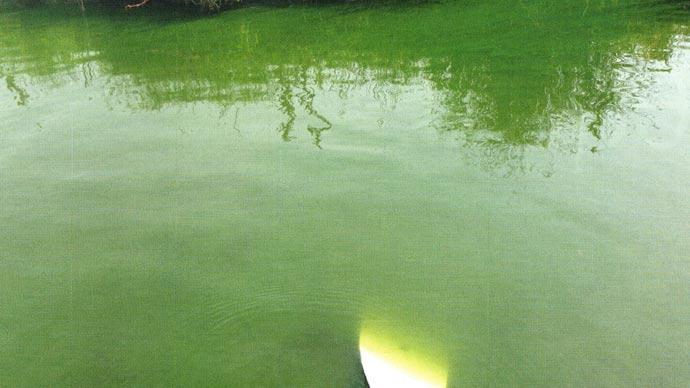This report is on a pond in Clay County, TX, located six miles north of Henrietta on the Oklahoma border. The pond was dug late in 1987 by bulldozer. It is nearly circular in shape, 14 feet deep and 150 feet across at the dam. I estirnate it holds 3.4 acre feet of water, when full.
The pond filled during the autumn of 1987 and spring of '88, but always stayed quite muddy. To clear it, I tried adding alfalfa hay, by segmenting six bales and stringing them across the pond on a rope. I did this in March 1988, with no apparent effect.
On April 3 that year, I put in six more bales and placed them around the edges. Visibility in the water at that time (measured by how deep I could see a six-inch white disc), was five inches or less. Again, even with the extra hay, I saw no improvement.
I sent water samples to Texas A&M for analysis, and received a report, along with a note saying the water was too soft for aquaculture. The report suggested I try gympsum tests in half-gallon glass jars. Even the five-tablespoon jar test took seven days to clear, and the control jar looked just as clear. I also tried filling the jar one-third full of well water. With only two-thirds of the jar filled with pond water, the test jar cleared faster in the presence of gypsum.
Then, I tried the gum tests, and jars treated with three and four spoons cleared nicely in 12 hours, so I tried the same application in my pond. On June 16, 1998, I put in 350 pounds of alum by pouring it into the slipstream of a 2 1/2-hp outboard motor on a boat tethered to shore. Visibility at the time of the treatment was five inches. By 8 o'clock the next morning, visibility had improved to six inches, then to seven inches by that afternoon at 5 p.m.
But by July 4, visibility was back down to six inches. The pond was two feet low at the time. I retested with alum jars, and each one cleared pretty well in eight hours.
Thinking that I might have underestimated the volume of the pond, I retreated it on July 24 with an additional 400 pounds of alum, along with 50 pounds of hydrated lime. Visibility at the time of the treatment was six inches. The next morning it was up to nine inches. By August 3, however, visibility was down to seven inches.
I then watched awhile. On August 20, following three calm days, visibility was 11 inches. On September 8, it was 10 inches.
Water levels were going down during this period, and by February 9, 1999, the pond was five feet low -- but visibility was 14 inches, so I thought it might be clear enough to start (planting) moss.
I can probably work with the pond if it stays this clear. I am now concerned about having killed all the fish with my treatments, as I can not seem to catch any. I know it had fish because in the spring of 1998, before treating, I stocked about 20 small bass and 100 perch plus five pounds of fathead minnows.
During the treatments, in May of 1998, I tried planting water primrose and water willow around the edges of the pond. I think I lost them as the water receded. I also put in five-gallon buckets of coontail moss, but they apparently did not survive.
I am watching to see if any (fish spawning) nests appear, and if it ever rains to raise the water level, I am hopeful the pond stays clear.
It seems likely to me that evaporation to the present level has concentrated the chemicals left by my treatments to promote clearing. Maybe this is why the old ponds around here stay clear.
(Note. The letter begs a response, so here's a follow by Bob Lusk, a member of the Pond Boss Field Advisory Staff.)
What a great letter! Just so you will identify with his problem, Mr. Cullum's pond happens to be near the Red River on the Oklahoma-Texas border -- where the reddest dirt greets the windiest seasons.
I happened to have worked his pond site, so I know that in North-Central Texas, muddy water is more the norm than the exception. To solve this dilemma, we need to understand water chemistry.
Water, the universal solvent, dissolves everything it can. Simply put, if water dissolves minerals, H20 stays clear. Minerals have electrical charges attached to their smallest components, called ions. Positively charged ions are called cations, negatively charged are anions. There can be no more positively charged ions than negatively charged ones.
But, some minerals will dissolve into water and leave water in an unbalanced state. Nature tries to adjust to the imbalance. If there are limited amounts of minerals to dissolve for balance, Mother Nature switches to the next available material -- minute pieces of dirt. In solution, this dirt creates that dreaded "chocolate milk" look to water.
To get rid of the dirt, pond managers must replace it with the properly charged mineral. So the pond owner is right on track.
Alum, also called aluminum sulfate, quickly alters the electrical charge of minerals in water, and can clear a muddy pond almost immediately. A mud hole can be as clear as drinking water in minutes. The problem? Alum, when it reaches the exact point chemically when mud settles, also rapidly adjusts pH.
A fast change in pH creates a serious problem for fish, and can kill them. When just the right amount of alum is applied, mud begins to flocculate, become heavy, and sink. The amount needed is based on the severity of the imbalance, and the volume of water.
Gypsum, on the other hand, works slowly, but is much less volatile. Gypsum or calcium sulfate, creates the same effect as alum, but with much less risk of dramatic pH change.
Here's the kicker. The pond owner must put exactly the right amount of material into the water and mix it well, or the materials will not dissolve. In order to figure out how much alum or gypsum to add, run the tests Mr. Cullum mentioned.
The key is accurately calculating the water volume. How much water is an "acre foot?" In approximate terms for the layman, it's enough fluid to flood a football field less than shin deep.
From his report, I can see that Mr. Cullum followed proper procedure, he just miscalculated the volume of water and failed to add enough gypsum and/or alum to really make a difference for an extended period. If the pond owner had reached what the financial wizards call "critical mass," he would have ended up with a clear-water pond.
As for why the coontail died, if the vegetation sank below the depths where sunlight could penetrate, the plants could not survive. Vegetation must have sunlight to live.
The fish probably survived, but in that turbid water, they just can't see well enough to bite a hook. Fishing will be poor until their numbers increase.
Two other observations: In Mr. Cullum's pond, the hay didn't work because the situation was chemical in nature. Sometimes ponds are muddy because of physical causes. There's a huge difference.
Physical causes -- cattle wading, wind whipping across shallow water or carp wallowing along the shoreline -- can disturb soils lying on the pond bottom and stir them into suspension. In some of these cases, I have found that hay may serve to settle the suspended sediment, and clear the water. Emphasize the "may;" the technique does not always work.
The water alternated between off-color and clear. Visibility would reach acceptable levels, then muddy up again. This can occur when alum or gypsum is concentrated in layers. Water at the top may appear to be clearing, but as the added materials begin to dilute, the water returns to its muddy status.
Reprinted with permission from Pond Boss Magazine



